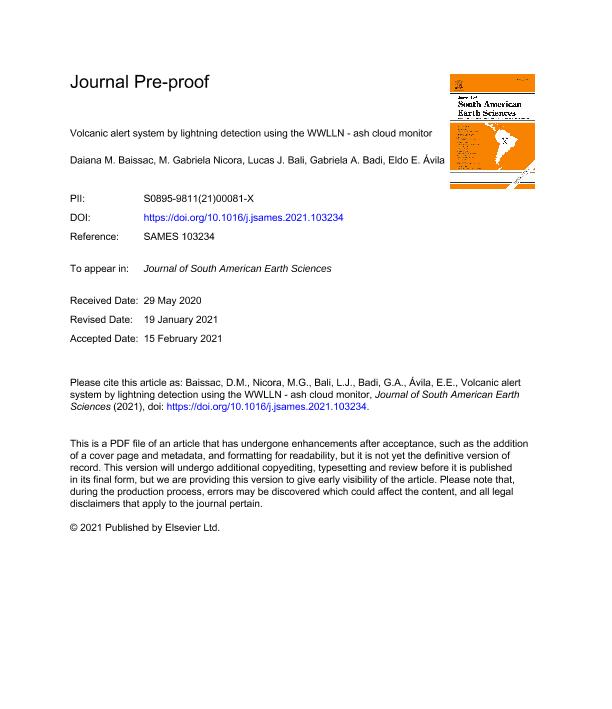Artículo
Volcanic alert system by lightning detection using the WWLLN - ash cloud monitor
Baissac, Daiana Marlene ; Nicora, Maria Gabriela
; Nicora, Maria Gabriela ; Bali, Juan Lucas
; Bali, Juan Lucas ; Badi, Gabriela A.; Avila, Eldo Edgardo
; Badi, Gabriela A.; Avila, Eldo Edgardo
 ; Nicora, Maria Gabriela
; Nicora, Maria Gabriela ; Bali, Juan Lucas
; Bali, Juan Lucas ; Badi, Gabriela A.; Avila, Eldo Edgardo
; Badi, Gabriela A.; Avila, Eldo Edgardo
Fecha de publicación:
06/2021
Editorial:
Pergamon-Elsevier Science Ltd
Revista:
Journal of South American Earth Sciences
ISSN:
0895-9811
Idioma:
Inglés
Tipo de recurso:
Artículo publicado
Clasificación temática:
Resumen
Electrical discharges are observed in many volcanic eruptions and they have often been used as indicators of such eruptions. Volcanic lightning is remarkably similar to those produced during thunderstorms and is called analogous to thunderstorm-like plume lightning. The WWLLN developed a program called "Ash Cloud Monitor" (ACM), in which alerts are issued for possible volcanic eruptions when lightning strokes are detected around a volcano. The ACM tool has demonstrated to be a very effective technique to be aware of volcanic eruptions. However, most of the alerts released by ACM belong to false alarms of volcanic activity, because, in general, the detected lightning is produced by thunderstorms near the volcano. In order to assess and improve the ACM to detect volcanic eruptions, reducing false alert emissions and improving the quick interpretation of them, we develop a web platform called GeorayosVolcanoAr with a new structure and a modified algorithm, with respect to the algorithm used by ACM, for the classification of alerts. The new algorithm considers an alert system with 3 levels: Red - Yellow - Green, with the Red alert being the highest level and decreasing towards Green. The Red alert was assigned to those volcanoes where only recorded lightning within a radius of 20 km or the lightning detected within a radius of 20 km is at least twice as much as that detected up to 100 km from the vent. The study focused on 32 volcanoes located in the Andes, close to the Argentine-Chilean border, and analyzed the results reported by the ACM network in terms of a climatological study of the lightning activity, thunderstorm days and predominant winds in that region. This analysis serves as a basis for a general recognition of the study zone in order to improve the interpretation of the distribution and generation of false alerts; as well as to help decision makers, among others, to have a reference that allows them to issue the warning.
Palabras clave:
ANDES
,
ASHFALL
,
MONITORING
,
VOLCANIC LIGHTNING
,
WWLLN
Archivos asociados
Licencia
Identificadores
Colecciones
Articulos(IFEG)
Articulos de INST.DE FISICA ENRIQUE GAVIOLA
Articulos de INST.DE FISICA ENRIQUE GAVIOLA
Articulos(SEDE CENTRAL)
Articulos de SEDE CENTRAL
Articulos de SEDE CENTRAL
Articulos(UNIDEF)
Articulos de UNIDAD DE INVESTIGACION Y DESARROLLO ESTRATEGICOS PARA LA DEFENSA
Articulos de UNIDAD DE INVESTIGACION Y DESARROLLO ESTRATEGICOS PARA LA DEFENSA
Citación
Baissac, Daiana Marlene; Nicora, Maria Gabriela; Bali, Juan Lucas; Badi, Gabriela A.; Avila, Eldo Edgardo; Volcanic alert system by lightning detection using the WWLLN - ash cloud monitor; Pergamon-Elsevier Science Ltd; Journal of South American Earth Sciences; 108; 103234; 6-2021; 1-29
Compartir
Altmétricas



